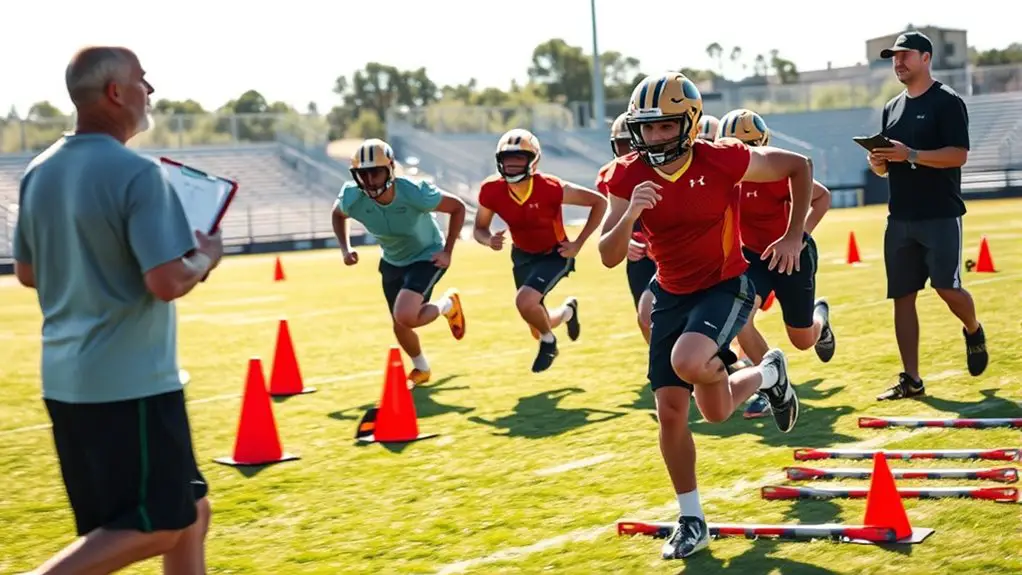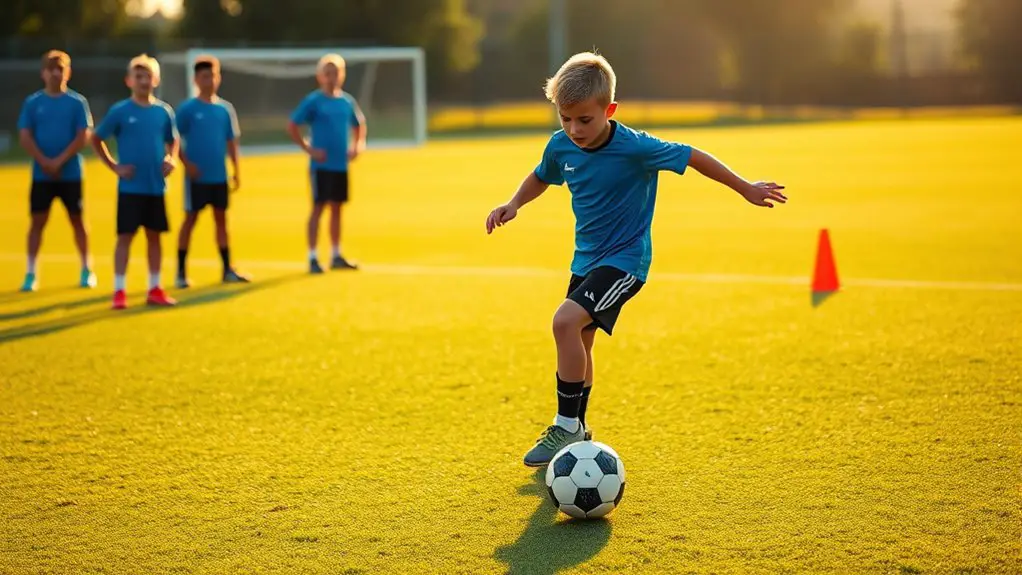To improve your ball control, focus on core exercises like planks, Russian twists, and bicycle crunches. Planks build foundational stability, while Russian twists enhance rotational strength. Incorporate medicine ball throws to boost power and coordination. Side planks engage lateral stability, and dead bugs improve coordination and control. These exercises not only strengthen your core but also elevate your overall performance. Keep exploring to discover even more effective drills and training tips for your game!
Planks for Stability
Planks are one of the most effective core exercises for building stability, and they're easy to incorporate into your routine. When you focus on core stability, you're laying the foundation for better movement and control. Start with a basic plank: face down, elbows under your shoulders, and keep your body straight. This simple position engages multiple muscle groups.
Once you're comfortable, mix it up with plank variations. Try side planks to target your obliques or add leg lifts for extra intensity. These variations not only keep your workouts fresh but also challenge your core in different ways. By integrating planks and their variations into your fitness journey, you're empowering yourself to move freely and confidently. Remember, a strong core translates into improved ball control, letting you express yourself on the field or court. So, embrace the power of planks, and watch your stability soar! Additionally, developing core strength reduces injury risk by supporting the spine during exertion.
Russian Twists for Rotational Strength
Russian twists are a fantastic way to build rotational strength, which is essential for effective ball control. This exercise engages your core rotation, helping you develop the muscle power needed to maneuver the ball effortlessly. To perform a Russian twist, sit on the ground, lean back slightly, and lift your feet off the floor. With a weight or just your hands, rotate your torso side to side. You'll feel your obliques working hard!
There are plenty of exercise variations to keep things fresh. Try using a medicine ball or a kettlebell for added resistance. You could also elevate your feet for an extra challenge. Incorporating these twists into your routine not only improves your core strength but also enhances your agility on the field. Additionally, core strengthening exercises allow for full expression of potential during matches, translating to better performance in your sport. So, get ready to release your skills and enjoy the freedom of movement that comes with stronger rotational power!
Bicycle Crunches for Core Engagement
Bicycle crunches are a fantastic way to engage your core effectively when done with proper technique. They not only strengthen your abdominal muscles but also improve your overall stability for better ball control. Let's explore how to perform them correctly and the benefits they bring to your fitness routine. Incorporating lower body strength exercises, such as squats, can further enhance your core stability and overall athletic performance.
Proper Bicycle Crunch Technique
While many core exercises exist, mastering the bicycle crunch can considerably enhance your ball control by engaging multiple muscle groups. Here's how to properly execute bicycle crunches for maximum core activation:
- Start from the floor: Lie on your back with your hands behind your head and legs lifted, knees bent at 90 degrees.
- Engage your core: As you bring your right elbow towards your left knee, extend your right leg out. Remember, it's about controlled movement, not speed.
- Switch sides: Alternate sides, focusing on the twist and keeping your lower back pressed into the floor.
With consistent practice, these steps will help you reveal the potential of your core, leading to greater freedom and control on the field.
Benefits for Core Strength
Strengthening your core is essential for enhancing overall athletic performance, and bicycle crunches are a fantastic way to achieve this. By incorporating them into your routine, you'll notice improved core stability, which translates to better balance and control during sports. With each pedal-like motion, you're engaging multiple muscle groups, ensuring your core becomes a powerhouse of strength. This not only supports your movements but also minimizes the risk of injury, giving you the freedom to play harder and longer. Plus, a strong core directly impacts your ability to maneuver and react during games, enhancing your ball control. So grab a mat and start those bicycle crunches; your athletic performance will thank you for it!
Medicine Ball Throws for Power and Coordination
Elevate your training routine with medicine ball throws, a dynamic exercise that enhances both power and coordination. This explosive movement not only builds your core strength but also improves your overall athletic performance. Here's how to make the most of your medicine ball throws:
- Start with a solid base: Stand with your feet shoulder-width apart and engage your core.
- Use explosive strength: Throw the ball with maximum force, focusing on correct technique to avoid injury.
- Incorporate different angles: Vary your throws—overhead, side, or chest—to target various muscle groups and enhance coordination.
Integrating medicine ball throws into your workouts will release your potential and give you the freedom to move with agility and strength. Additionally, this exercise emphasizes core stability and strength crucial for enhancing athletic performance. It's time to level up your game and feel the difference in your ball control!
Side Planks for Lateral Stability
Side planks are essential for building lateral stability, which is vital for maintaining control during dynamic movements. You'll want to focus on proper form to maximize their benefits and prevent injury. Plus, there are several variations you can try to progress your strength and stability over time. Incorporating mobility training into your routine can enhance overall agility and improve your performance on the field.
Benefits of Side Planks
While you might primarily think of planks as a core exercise, side planks play an essential role in enhancing lateral stability. By incorporating side planks into your routine, you're not just strengthening your core; you're also improving your overall performance on the field. This exercise promotes core engagement and muscle activation in a way that's vital for dynamic movements.
Here are some key benefits of side planks:
- Improved Balance: Strengthens stabilizing muscles, helping you maintain control during lateral movements.
- Enhanced Core Strength: Engages multiple muscle groups, leading to better overall stability.
- Injury Prevention: Reduces the risk of strains by building resilience in your core and hips.
With side planks, you're setting yourself up for greater freedom of movement and improved ball control.
Proper Form Guidelines
To achieve the maximum benefits from side planks, it is crucial to maintain proper form throughout the exercise. Focus on engaging your core muscles to stabilize your body. Here are some exercise tips to keep in mind:StepActionKey Reminder Start Position Lie on your side Keep your body straight Elbow Placement Position under shoulder Avoid sinking your hips Leg Placement Stack your feet together Keep legs aligned Core Engagement Tighten your abdominal muscles Don't hold your breath Duration Hold for 30 seconds Focus on control
Variations for Progression
As you become more comfortable with standard side planks, incorporating variations can enhance your lateral stability and challenge your core even further. These exercise variations not only keep your routine fresh but also help you master essential progression techniques. Here are three effective variations to try:
- Side Plank with Leg Lift: Elevate your top leg while maintaining your position, engaging your obliques.
- Rotating Side Plank: Rotate your torso to reach under your body, then back to the plank, improving dynamic stability.
- Side Plank with Hip Dip: Lower your hip towards the ground and raise it back up to build strength through the entire range of motion.
Dead Bugs for Coordination and Control
Dead bugs might sound playful, but they're a serious exercise for enhancing coordination and control. When you lie on your back with arms and legs lifted, it may seem simple, but this position forces you to engage your core while moving limbs in opposite directions. As you practice this, you're not just having fun; you're honing essential coordination drills.
Incorporating dead bugs into your routine can greatly improve your ball control techniques. By maintaining stability while your limbs move, you're training your body to respond fluidly, whether you're dribbling, passing, or shooting. The beauty of dead bugs lies in their versatility; you can adjust the difficulty by changing the speed or adding resistance. Furthermore, consistent mobility training can reduce injury risk, allowing you to practice these exercises safely and effectively.
Frequently Asked Questions
How Often Should I Perform These Core Exercises?
You should aim to perform core exercises about three to four times a week for ideal results. This frequency allows your body to recover while still making progress. You can mix in different exercise variations to keep things fresh and engaging. Don't forget to listen to your body—if you're feeling fatigued, take a break. Balance is key, and you'll find your rhythm while enjoying your fitness journey!
Can Beginners Do These Exercises Safely?
Imagine stepping onto a field, feeling the grass beneath your feet, ready to embrace new challenges. Yes, beginners can safely do these exercises, but it's essential to listen to your body. Start with beginner modifications, like reducing the intensity or duration. Always prioritize safety precautions, such as warming up properly and using correct form. You'll find freedom in movement, gradually building strength and confidence as you progress on your fitness journey.
What Equipment Do I Need for These Exercises?
For the exercises, you won't need much equipment. A yoga mat's great for comfort, and a stability ball can enhance your core stability. If you're up for it, resistance bands offer exercise variations to challenge yourself further. You might also consider dumbbells for added resistance, but they're optional. The freedom to choose your equipment lets you tailor your workout to your preferences, so pick what feels right for you and get started!
How Long Should Each Exercise Session Last?
Isn't it ironic how you think you need to spend hours working out to see results? In reality, a session duration of 20 to 30 minutes can be incredibly effective if you focus on exercise intensity. You'll find that shorter, more concentrated sessions keep your energy high and your motivation intact. So, embrace the freedom of brevity; you don't have to sacrifice quality for time when it comes to your workouts!
Are There Any Warm-Up Recommendations Before Starting?
Before starting, it's essential to warm up properly. You should incorporate dynamic stretching to get your muscles ready and increase blood flow. Think about movements like leg swings and arm circles. Additionally, focus on core activation exercises, like planks or bird dogs, to engage your core. This way, you'll feel more liberated and ready to move freely during your workout. Take these steps, and you'll enhance your overall performance!




